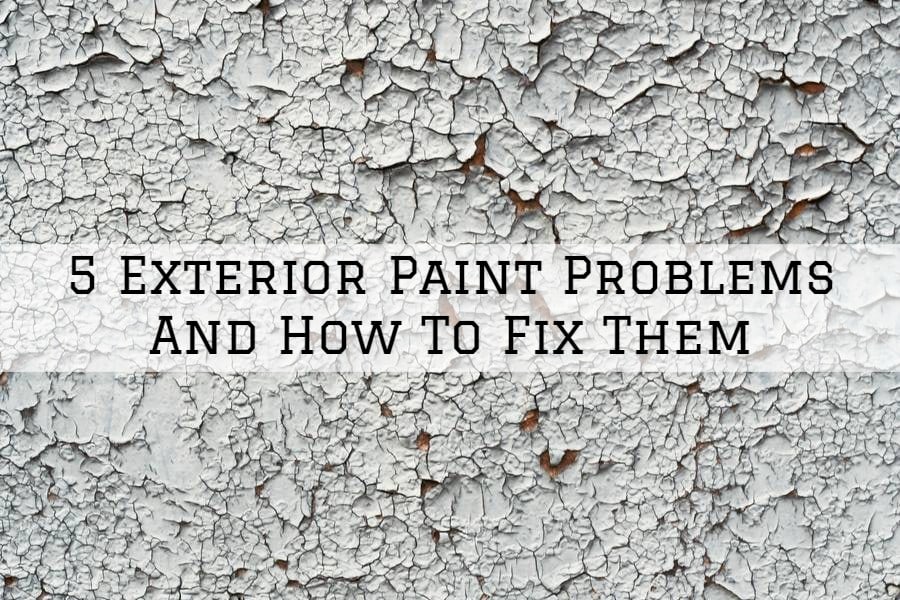Weather conditions such as extreme heat coming from the sun, rainfall soaks, and changes in temperature can cause problems with your exterior paint.
You cannot avoid having these exterior paint problems, but knowing some of them and how to fix them can come in handy.
With that in mind, here are 5 exterior paint problems and how to fix them in Newtown, PA.
Exterior Paint Problem #1: Peeling Paint
One of the most common exterior paint problems is peeling paint, where your paint peels off from the surface.
The reason for this is most probably poor adhesion, however, there can also be other reasons behind it.
Some other reasons for peeling paint can include:
- Applying paint to a surface that is dirty, wet, or shiny
- Not enough drying time between coats
- Using low-quality paint
- Blistering paint
Here are the things that you can do to fix a peeling paint:
- Scrape off the peeling paint
- Sand the area as smooth as possible
- Prime before you start painting
- Use the right caulking product
- Use high-quality paint
Exterior Paint Problem #2: Mildew
Mildew is a particular form of mold or fungus.
It is known for its green, brown, gray, or black spots that feed and grow on the paint film.
Here are some reasons that cause mildew:
- Lack of ventilation
- Moisture
- Insufficient sun exposure
- Applied paint on a surface that has mildew
- Using low-quality paint
- Not priming before painting bare wood
Here are the things that you can do to fix mildew:
- Scrub it with trisodium phosphate (TSP)
- Rinse with clean water, wash it with detergent, then rinse again
- Use high-quality paint
- Don’t forget to prime before you paint bare wood
Exterior Paint Problem #3: Blistering Paint
Blistering paint also called bubbling paint, is the blisters or bubbles underneath the paint film.
It is usually seen on wood trims and sidings.
Here are some reasons that cause blistering paint:
- Applying your new paint under when the heat coming from the sun is too intense (this causes the solvent vapor to get trapped because the paint dried too fast)
- Applying your new paint to a wet surface (this causes the moisture to get trapped, which makes the paint film expand)
- Improper house ventilation that causes moisture to escape through the walls
Here are the things that you can do to fix blistering paint:
- Apply your new paint when the heat coming from the sun is not too hot
- Scrape off blistered paint
- Sand to bare wood
- Allow enough time for the wood to dry totally
- Prime the wood before you paint
- Consider having some siding ventilation
Exterior Paint Problem #4: Rust Stains
Rust stain is also one of the common exterior paint problems.
It is the reddish-brown to black stains on the painted surface of the exterior of your home.
Here are some reasons that cause rust stains:
- Using non-corrosion-resistant nails to attach your sidings
- Steel nails have popped up, which causes it to have air contact, eventually develops rust stains
- Excessive sanding has removed the galvanized coating on the nail heads
- Black stains are most probably due to the reaction between tannic acid from moist wood and steel nails.
Here are the things that you can do to fix rust stains:
- Use stainless steel nails to attach your sidings
- Hammer the steel nails to the point that they won’t pop up
- If you cannot remove a rusted nail, get rid of its rust by sanding its nail head and applying a stain-blocking primer
- Use high-quality paint
Exterior Paint Problem #5: Alligatoring and Checking
Alligatoring is the cracked pattern, that resembles a reptile’s skin.
Checking is almost the same as alligatoring, but it’s less severe and characterized by long and spaced cracks in the paint film.
Here are some reasons that cause alligatoring and checking:
- Applying a second coat of primer to a first coat that’s still wet
- Applying a second coat over an incompatible paint (for example: glossy paint)
- Oil-based paint loses its elasticity after a long time that leads to cracks because of the changes in temperature.
The term ‘‘alligatoring’’ refers to minor bumps or ridges that develop on the surface of a coating. Alligatoring is caused by multiple factors, including the age of the paint film and environmental changes, and extreme temperatures. Differences can be observed in flat and gloss paints, showing minor chips or protruding areas at the edges and corners. Paint surfaces that have been treated with alligatoring can create an overall discolored appearance. It can result from improper humidity conditions during painting (e.g., the insufficient time between coats).
Here are the things that you can do to fix alligatoring and checking:
- Scrape off your old paint
- Sand until smooth
- Prime before you paint
- Apply a second coat when the first coat is dry totally
- Use high-quality paint
If you need professional help with your interior/exterior painting project, PAINT Philadelphia can help.
Our home interior/exterior painting services are available in Newton, Holland, and Richboro, PA.
Call us today at (267)682-8377 for a FREE painting estimate.
Related: 7 Tips For Painting Your Home’s Exterior in Newtown, PA
7 Tips For Painting The Interior Of Your Home In Newtown

Andrew Tomasetti is not just a painting contractor, he is the owner of Paint Philadephia; a painting company in the greater Philadephia area that services the Holland, Newtown, Churchville, Yardley, Richboro areas.
Paint Philadephia is an interior, exterior and cabinet painting company that offers their customers top-notch services and their exclusive “On Time, On Dime” guarantee. They take a holistic view to all of their paint jobs offering free color and design consults, test samples, free touch ups on all painting projects, and warranties on all of their work.
Andrew Tomasetti is both a veteran and an engineer. His passion for hands-on work comes from his father and uncle and runs deep in his veins.

